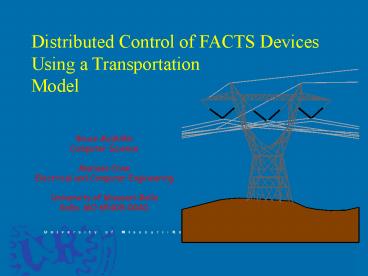Fault-Tolerant and Secure Intelligent Vehicle Highway System Software - a Safety Prototype - PowerPoint PPT Presentation
1 / 32
Title:
Fault-Tolerant and Secure Intelligent Vehicle Highway System Software - a Safety Prototype
Description:
Title: Fault-Tolerant and Secure Intelligent Vehicle Highway System Software - a Safety Prototype Author: Rob Mensching Last modified by – PowerPoint PPT presentation
Number of Views:252
Avg rating:3.0/5.0
Title: Fault-Tolerant and Secure Intelligent Vehicle Highway System Software - a Safety Prototype
1
Distributed Control of FACTS Devices Using a
TransportationModel
Bruce McMillin Computer Science Mariesa
Crow Electrical and Computer Engineering Universi
ty of Missouri-Rolla Rolla, MO 65409-0040
2
Outline
- FACTS Devices
- Max Flow
- Suitability of Max Flow to Power System
- Distributed Max Flow
- Fault Tolerance of Distributed Max Flow
3
Project Motivation
- Due to large unidirectional power flows,
transmission grids are becoming increasingly
susceptible to cascading failures - Decentralized network control is necessary to
rebalance power flow and contain the extent of
the cascade
4
- FACTS devices offer a decentralized
network-embedded control mechanism
5
Project Objective
- Develop an effective distributed FACTS control
algorithm to mitigate cascading grid failures,
either intentional or unintentional - Make the developed algorithms fault-tolerant
using formal methods based on power system
specifications
6
Approach
- The embedded controllers will execute
graph-theory-based - max flow distributed algorithms to identify
critical transmission corridors and adjust power
flow accordingly to avoid cascading failures
7
Outline
- FACTS Devices
- Max Flow
- Suitability of Max Flow to Power System
- Distributed Max Flow
- Fault Tolerance of Distributed Max Flow
8
Example
9
(No Transcript)
10
Max-Flow
- Assign an initial flow to all arcs
- Mark the source and sink
- Search for a node that can be labeled. If none is
found, flow is maximum, stop. - Backtrack the path computing the minimum ?ij
used. Go to previous step.
11
10
12
Loss of Line B-D
- Load at bus D must be reduced from 20 to 15
- Load at bus C must be reduced from 30 to 27
13
Outline
- FACTS Devices
- Max Flow
- Suitability of Max Flow to Power System
- Distributed Max Flow
- Fault Tolerance of Distributed Max Flow
14
Suitability of Transportation Model (max flow)to
Power Systems?
- Losses and Reactive Power?
- Experimental Verification
- No difference at steady state from max flow
- A few percent difference between max flow
calculations and load-flow analysis after a
contingency using FACTS devices
15
- In general, lines are not all maximally loaded.
The power flow can then be re-directed to new
transmission corridors. - Where re-direct?
- How much to re-direct?
- How account for KCL?
- Control/communication between decision-making
devices?
16
Placement of FACTS Devices
- Experimentally
- Delete a line
- Run Max Flow servicing loads increasing line
capacities by reverse augmentation to a maximum
of 20. - Using Load Flow analysis, place FACTS devices to
eliminate overloaded lines. - Go to step 1
17
Placement of FACTS Devices
18
Resulting System Configuration
19
Resulting Line Overloads (gt20)
20
Outline
- FACTS Devices
- Max Flow
- Suitability of Max Flow to Power System
- Distributed Max Flow
- Fault Tolerance of Distributed Max Flow
21
Distributed Max flow
- Multiple source (generator)
- Concurrent flow-augmenting probes
- FACTS devices communicate by message passing
along the direction of the flow augmentation - Each FACTS device computes the flow for a
partition of lines (using Chaco from Sandia) - Multiple Computers, Open Communication Lines,
Distributed Software
22
Outline
- FACTS Devices
- Max Flow
- Suitability of Max Flow to Power System
- Distributed Max Flow
- Fault Tolerance of Distributed Max Flow
23
Vulnerabilities
- Computer System Failure
- Programming Errors
- Hackers (Security Intrusions)
24
Software Correctness?
- Distributed Computing System
- Verification (Development Time)?
- Complexity
- Model Checking and Theorem Proving
- Testing
- Test Cases
- Monitoring
- Assertion Testing.
25
Proposed Idea
Combine assertions from formal verification with
run-time checking (monitoring).
26
Proposed Approach
- Distributed run-time assertion checking
- focuses on the unique execution in progress -
guarantees that the current execution meets its
specifications regardless of underlying hardware
or system confidence
27
Embedded Monitoring
- Assertions are predicates are a collected global
state of events - If an event happens before another they can be
partially ordered - Lamport Logical Clock
- Each event has a logical timestamp Cevent
- The most current event is the one with the
largest timestamp. - Timestamps are forced to increase on a message
receive so that message sends precede message
receives.
28
Underlying Theory
- Correctness is defined by theorems about the
program. Theorems are easily translated into
assertions for monitoring. - For the assertions to be correct, a program code
action, a, must not interfere with the truth of
an assertion, P - (ltP pre(a)gt a ltPgt).
- In a distributed system, this truth must be
preserved over all interleavings of processes. - Using timestamps, the monitoring is guaranteed to
correctly reflect the distributed programs
state.
29
Failure Scenario
- Distributed Multiple Source Max Flow
- Correctness is defined by KCL at each node
- FACTS devices B and C faulty
- Attempt to Overload line B-C (flow20)
30
Failure Scenario
31
System Framework
32
Status and Results
- Simple Max Flow is an effective formalism to
balance power flow - Detects Faults
- Need to measure performance and fault tolerance
levels. - Real-Time algorithm needs to respond before
cascading failure occurs.































